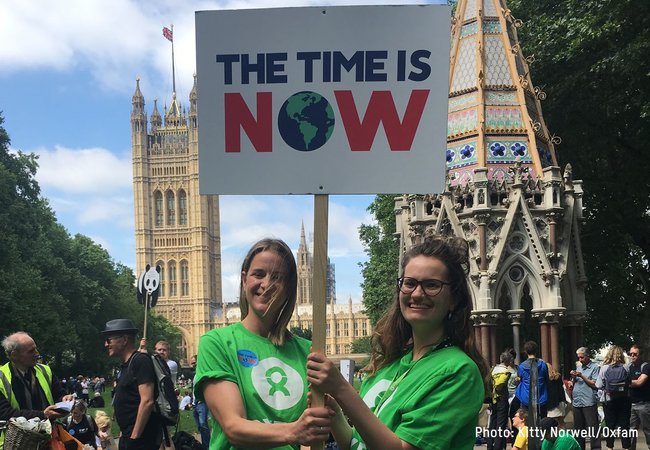Kitty Norwell/Oxfam


Ideas for taking climate action at home
Activities for ages 7-14
Join with others in tackling the climate crisis
- Climate change is affecting millions of the world’s poorest people, right now.
- More frequent and extreme weather, like storms and droughts, are destroying homes, lives and livelihoods.
- There is still hope but urgent action is needed now.
- Inspired by some of the communities Oxfam works with around the globe, we’ve put together five ideas for taking action at home.
- We can all play a vital role in saving our planet and its people.
Sacha de Boer/Oxfam Novib
Learn-Think-Act
- Learn about issues
- Think about how to solve them
- Act as responsible global citizens
1. Set your recycling creativity free
Reduce, reuse, recycle!
- Go on a hunt for any empty packaging in the house such as cardboard boxes, bottle tops, foil. Make sure that items are clean and free from sharp edges.
- Now get to work at making your waste masterpiece. Toys, games, musical instruments - the opportunities are endless!
The boy who sees treasure wherever he goes.
Martin and his friends live in Bidibidi, a giant refugee settlement in Uganda. They make toy cars from the things they find around them.
Think about the environmental issues of waste and packaging:
Reduce – How could people avoid using packaging? Repairing rather than replacing things is one way of buying less ‘stuff’. Buying bulk items rather than lots of smaller ones is another option.
Reuse – What else could empty packaging be used for? For example, plastic bottles and rolls of newspaper could be used as plant pots. Empty glass jars could be used as food containers.
Recycle – What packaging can be recycled and what can’t? How much of your household’s weekly waste is non-recyclable? What do the different recycling symbols on household packaging mean.
What will you create from the 'rubbish' you find?
2. Harness the power of worms
- Global food wastage causes more carbon emissions than the majority of countries in the world.
- 37% of carbon emissions from food waste happen when food is prepared and after it's eaten. So we can all make a big difference by wasting less food at home.
- One way you could take action is by composting your food waste. Most gardens have space for a compost heap and you don’t need much equipment to get going.
- If you don’t have a garden, you could always use an indoor worm composting bin or try building your own mini wormery.
- There are lots of online sources of useful information, practical tips and fun activities for teaching children about the importance of composting. Here's a link from the RSPB to get you started.
Poo-eating worms!
Micro-organisms are an essential part of the composting process but other creatures such as worms also play an important role. Oxfam has been working with communities to provide specially designed toilets which use worms to decompose human poo and turn it into clean, safe fertiliser.
Toilets have been built in Sierra Leone. Similar ones have been used in camps in Myanmar, Ethiopia and Bangladesh. The aim is to build hundreds more!
3. Carry out a home energy audit
- Go around your home and make a list of the different ways in which you use energy. For example to turn on lights, heat the house, cook, or power a phone or tablet.
- You could print off the home energy audit activity sheet to use. Or else you could create your own table on a piece of paper to record your findings.
- Now think of ways in which you and everyone in your household could use energy more efficiently. Write your ideas on the home energy audit activity sheet.
Maybe you could:
- investigate ways to better insulate your home,
- make little posters to remind people to turn off lights and appliances,
- replace less efficient light bulbs with more efficient LED ones.
The Energy Saving Trust has lots of useful suggestions.
Perhaps you could take gas and electricity meter readings and then challenge your household to reduce your usage. Not only will you be helping to reduce your carbon footprint, you’ll also save money at the same time!
4. Make do and mend
- 4% of global CO2 emissions are caused by the clothing and apparel industry.
- When a pair of jeans is made new, an estimated 16.2kg of CO2e is emitted – the equivalent of driving over 58 miles in a car!
- Switching from new to second hand clothes can make a big difference to your carbon footprint.
- Every new thing we buy has a carbon footprint. Getting furniture, electricals and clothes repaired can give them a longer life and reduce your environmental impact.
- Oxfam has been doing the reusing and reselling thing since the 1940s, when the first Oxfam shop opened.
- Then, in 1974, Oxfam became the first national charity to develop its own facility for recycling and reusing clothes!
Clothes recycling
At Oxfam, we work very hard to find a new use for every item of clothing you give. This includes being sold in our high street shops around the UK, on Oxfam's Online Shop, and to fashion designers who restyle garments and reuse fabrics. Damaged or low-grade items can be sold to recycling traders so they can, for instance, be turned into car soundproofing or mattress stuffing.
A few ideas for reducing the amount of ‘stuff’ in our world:
- Have a clear out and put aside the clothes, books and toys you no longer need or want.
- Mend, upcycle or repair something to give it a new lease of life.
- Reuse some unwanted clothes or fabric by making it into something else. It’s easy to search for ideas online, see the make your own bunting resource sheet for some initial inspiration.
5. Spread the word
- Finally, one last important way of taking action is by raising awareness of an issue among others.
- Jessy and Isaac are two young people living in Malawi. They are proud to help raise awareness of how climate change is impacting people’s lives now and why urgent action is needed.
- Together with their headteacher, Jessy and Isaac visited the UK in 2019. They met with other young people to share experiences and ideas about the impacts of the climate crisis and what action is needed.
- They also took part in a climate rally in London. Watch the video to find out more:
How could you spread the word?
- Talking to family and friends is one way to start.
- Share some facts about the causes and impacts of the climate crisis; talk about thoughts and feelings about climate change; discuss what action you could take.
- Perhaps you could talk to an elderly relative about how the environment and our lifestyles have changed during their lifetime.
Further learning
The Human Impact of Climate Change
With links across the curriculum, these Oxfam education resources use stories, film and role play to explore the human element of the climate crisis.
Explore the activities for primary schools
Explore the activities for secondary schools
Sustainable Fashion - A Guide for Teachers
Aimed at teachers working with ages 9-16, this guide is filled with useful information, cross-curricular activity ideas and inspiration for learning about the impacts of fast fashion.
NASA’s Climate Kids
This website provides information, activities and games to support learning about the science of climate change and sustainability:
Visit climatekids.nasa.gov
Take Action for Climate Justice
This short guide for teachers is packed with practical advice, classroom activities and helpful planning tools to inspire young people to take action for climate justice at school.